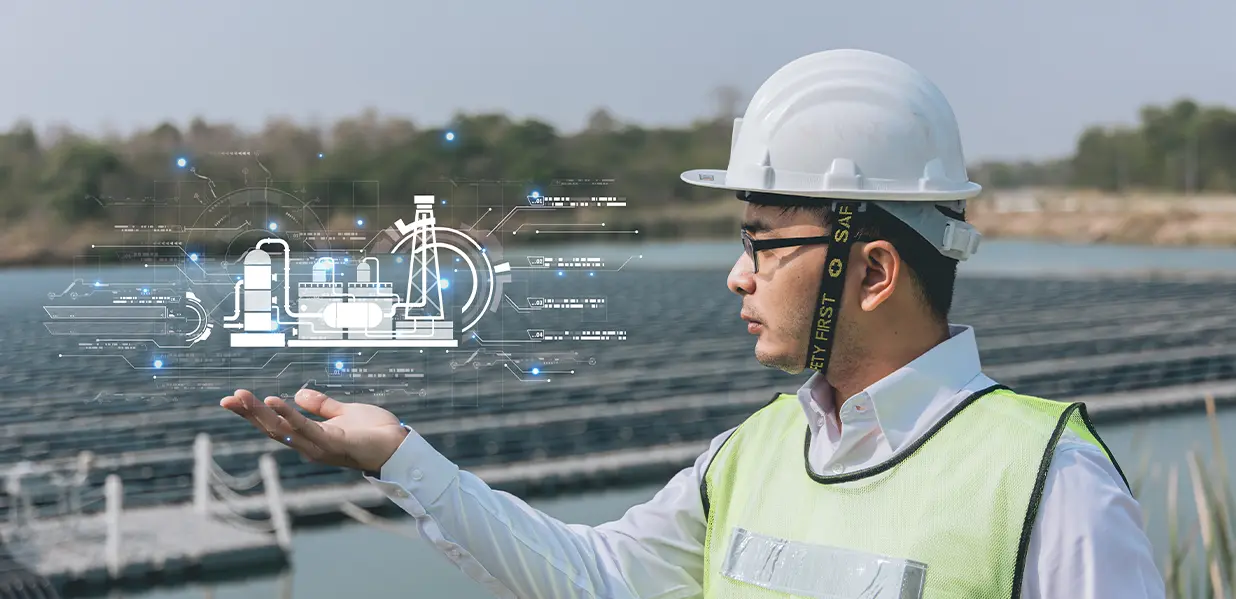IoT in Construction for Environmental and Structural Monitoring
Integrating the Internet of Things (IoT) into the construction industry represents a transformative leap toward enhanced safety, efficiency, and environmental stewardship. This technology, through its sophisticated network of sensors and devices, offers unprecedented capabilities in monitoring structural health and assessing environmental impacts.
As we delve into the specifics of Structural Health Monitoring, Environmental Impact Assessment, and the deployment of Sensor Networks in Construction, we'll uncover how IoT is setting new standards for safety, sustainability, and efficiency in an industry that is foundational to our modern way of life.
Join us in exploring how the integration of IoT in construction is not just a trend, but a critical evolution towards smarter, safer, and more environmentally friendly building practices.
Structural Health Monitoring (SHM)
Structural Health Monitoring (SHM) is a pivotal technology in the construction industry, designed to enhance the safety, longevity, and reliability of infrastructure and buildings.
With advanced technologies, SHM offers a dynamic and proactive approach to maintaining structural integrity, which is crucial for the well-being of the public and the preservation of our built environment.
The integration of Internet of Things (IoT) technology into SHM systems marks a significant advancement in how we monitor and maintain structures, from residential buildings to critical infrastructure like bridges and dams.
Key Aspects of Structural Health Monitoring
- Real-time Data Collection: SHM systems utilize a variety of sensors to collect data on the physical condition of structures in real time. This includes monitoring for cracks, deformations, and other signs of structural wear or damage.
- Early Warning Alerts: By analyzing the collected data, SHM can provide early warnings about potential structural issues before they escalate into serious problems. This allows for timely interventions, which can prevent accidents and save lives.
- Cost Reduction: Implementing SHM can lead to significant cost savings by identifying problems early, thus reducing the need for expensive repairs or replacements. It extends the lifespan of structures, making them more sustainable and cost-effective in the long term.
IoT's Enhancement of SHM
- Continuous Monitoring: IoT technology enables continuous and automated monitoring of structures by embedding sensors that can measure critical parameters such as vibrations, tilt, strain, and humidity.
- Centralized Data Analysis: The data collected by IoT sensors is relayed to centralized systems for analysis. This facilitates the early detection of any anomalies that might indicate potential failures or weakening of the structure.
- Accessibility: IoT makes it easier to monitor hard-to-reach or aging infrastructure, ensuring that all structures, regardless of their location or age, can be maintained properly and efficiently.
- Scalability: IoT technology allows for scalable SHM solutions that can be customized to the specific needs of different types of structures, from single buildings to complex infrastructure networks.
Environmental Impact Assessment (EIA)
Environmental Impact Assessment (EIA) is a fundamental component in the planning and execution of construction projects, serving as a critical tool for sustainable development.
EIA assesses the potential environmental impacts associated with construction activities, aiming to mitigate adverse effects on the natural and human environment.
The process ensures that environmental considerations are integrated into project planning and decision-making, promoting environmental stewardship and compliance with regulatory standards.
Key Elements of Environmental Impact Assessment
- Systematic Evaluation: EIA involves a thorough and systematic evaluation of potential environmental impacts, including effects on biodiversity, water and air quality, soil, and the socio-economic conditions of local communities.
- Mitigation of Negative Impacts: The primary objective of EIA is to identify and mitigate negative environmental impacts before project implementation. This includes proposing alternatives, designing mitigation measures, and monitoring environmental performance.
- Regulatory Compliance: EIA ensures that construction projects adhere to environmental laws and regulations, facilitating the acquisition of necessary environmental permits and approvals.
Enhancing EIA with IoT Technologies
- Real-Time Monitoring: IoT technologies enable the continuous monitoring of environmental parameters such as air and water quality, noise levels, and soil conditions. This capability allows for the collection of precise and up-to-date environmental data.
- Data-Driven Decision-Making: The real-time data provided by IoT sensors supports more informed decision-making throughout the project lifecycle. Project managers can use this data to adjust construction practices in response to environmental changes, ensuring minimal ecological disruption.
- Improved Accuracy and Efficiency: By deploying sensor networks, EIAs can achieve greater accuracy and efficiency in environmental monitoring. This technological integration enhances the ability to predict and assess potential environmental impacts, leading to better environmental management and protection strategies.
- Compliance and Sustainability: IoT-enhanced EIA processes help ensure that construction projects comply with environmental standards and regulations. Moreover, the use of IoT technologies in environmental monitoring supports sustainable construction practices by enabling the proactive management of environmental risks.
Sensor Networks in Construction
Sensor networks in construction, powered by the Internet of Things (IoT), have revolutionized how the industry approaches project management, safety, and environmental sustainability.
These networks comprise a vast array of sensors strategically distributed across construction sites or embedded within structures, serving as the critical interface between the physical construction environment and digital monitoring systems.
The data collected by these sensors offer invaluable insights into various aspects of construction projects, from ensuring structural integrity to optimizing resource use.
Core Functions of Sensor Networks in Construction
- Data Collection on Environmental Conditions and Structural Integrity: Sensor networks gather comprehensive data on factors affecting structural health and environmental conditions, such as temperature, humidity, vibration, and pressure.
- Real-time Monitoring and Analysis: The continuous stream of data allows for real-time monitoring and analysis, enabling construction managers to make informed decisions promptly.
- Enhanced Safety and Efficiency: By providing detailed insights into site conditions, sensor networks play a crucial role in enhancing workplace safety and operational efficiency.
Multifaceted Applications of Sensor Networks
- Workplace Safety: Sensors monitoring air quality and toxic gas levels ensure the safety of construction workers by alerting them to hazardous conditions. This proactive approach to safety can significantly reduce the risk of accidents and health issues on construction sites.
- Productivity Enhancement: Temperature and humidity sensors are vital in optimizing concrete curing processes, ensuring that the material achieves its required strength efficiently. This precise management of construction processes enhances overall project productivity.
- Waste Reduction: IoT sensors can detect inefficiencies and waste in resource use, enabling construction sites to adopt more sustainable practices by minimizing waste and optimizing resource allocation.
- Equipment Tracking and Management: IoT-enabled tracking systems monitor the location and status of construction equipment, reducing the likelihood of theft and loss. These systems also help in optimizing the use of equipment, ensuring that resources are allocated efficiently across the project.
Conclusion
The integration of IoT in construction for environmental and structural monitoring heralds a new era of intelligent, sustainable, and safe construction practices. Structural Health Monitoring and Environmental Impact Assessment, empowered by advanced sensor networks, not only ensure the safety and durability of construction projects but also safeguard the environment.
As the construction industry continues to embrace digital transformation, the potential of IoT technologies to drive innovation and efficiency seems boundless. By investing in IoT, stakeholders can enhance project outcomes, fulfill regulatory requirements, and contribute to a more sustainable future.
The journey towards smarter construction is not without challenges, including data security, privacy concerns, and the need for significant investment. However, the benefits far outweigh the obstacles, making IoT an indispensable ally in the quest for resilient, eco-friendly, and efficient construction practices.
Hence, if, you are really looking forward to implement IoT for Environmental Impact Assessment and Structural Health Monitoring, contact us right away.
We have cutting edge technologies in our hands, with dedicated and skilled staff. We take proud with what we deliver to our clients and ensure 100% satisfaction.
You can also schedule a call with our expert to discuss your specific requirements in detail.
 June 27, 2025
June 27, 2025
 Balbir Kumar Singh
Balbir Kumar Singh
 0
0
 June 13, 2025
June 13, 2025
 Balbir Kumar Singh
Balbir Kumar Singh
 0
0
 May 30, 2025
May 30, 2025
 Balbir Kumar Singh
Balbir Kumar Singh
 0
0
 June 27, 2025
June 27, 2025
 Balbir Kumar Singh
Balbir Kumar Singh
 0
0
 June 13, 2025
June 13, 2025
 Balbir Kumar Singh
Balbir Kumar Singh
 0
0
 May 30, 2025
May 30, 2025
 Balbir Kumar Singh
Balbir Kumar Singh
 0
0
 June 27, 2025
June 27, 2025
 Balbir Kumar Singh
Balbir Kumar Singh
 0
0
 June 13, 2025
June 13, 2025
 Balbir Kumar Singh
Balbir Kumar Singh
 0
0
 May 30, 2025
May 30, 2025
 Balbir Kumar Singh
Balbir Kumar Singh
 0
0









Leave a Reply